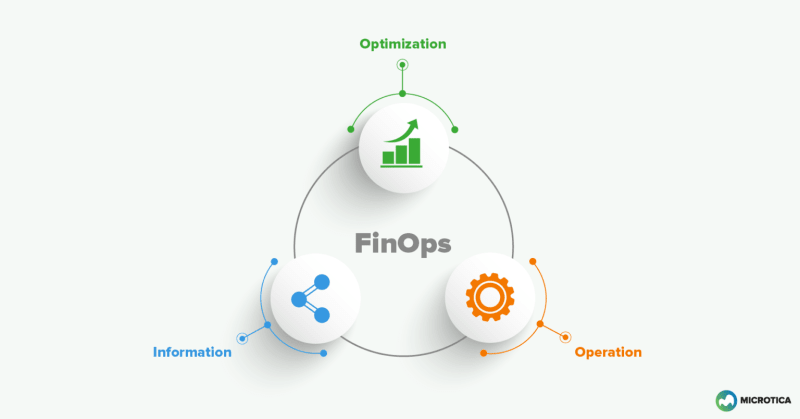As a part of our cost optimization series, we already talked about the most common AWS cost optimization challenges and the reasons why every company needs to solve this. In this article, we’re talking about FinOps as a way to optimize cloud costs.
To solve their cloud cost optimization problems, some companies develop FinOps practices. FinOps refers to Cloud Financial Management. It is the process of adding financial transparency to the cloud’s variable expenditure model. The goal is to empower teams to balance between speed, expense, and quality.
Check out our comprehensive guide on creating an AWS cost optimization strategy.
FinOps is, at its heart, a cultural shift. In order to facilitate quicker execution, cross-functional teams operate together. At the same time, acquiring more financial and organizational power is also a priority.
FinOps allows all operating teams to access real-time data they need to impact their expenditure and make wise choices that eventually contribute to successful cloud cost optimization without affecting the performance, speed, and quality of the final product.
FinOps is all about eliminating obstacles. It enables innovation teams to produce better features, software, and migrations more rapidly. It also allows a cross-functional discussion about when and where to spend. An organization can sometimes plan to cut back on spending, while other times it will decide to spend more. Yet, teams have to know why they make the choices.
The FinOps process
According to the FinOps Foundation, the FinOps process has three phases: inform, optimize, and operate.
The inform phase is when the company gains visibility over the allocation of its resources. During this phase, the focus is on where our resources have been allocated, what is the state of our budget, and what kind of future awaits with this setup. For wise decisions, the on-demand and dynamic nature of the cloud, along with personalized pricing and incentives, makes it possible for precise and real-time visibility. Based on tags, accounts, or company mappings, the correct distribution of cloud spending enables detailed chargeback and showback. Other interested parties also want to confirm that the focus remains on ROI. At the same time, they want to remain within the budget and predicting spending precisely, eliminating uncertainties.
The second phase is optimize, when the team has to identify cost optimization opportunities and act accordingly. The goal is to spend resources more efficiently, avoiding waste. To help teams optimize, cloud vendors offer multiple tools. The most costly is on-demand power. Cloud services provide discounts on commitments that usually require complicated estimates for making reservations to facilitate advanced reservation preparation and improved participation. Furthermore, departments and companies can optimize the setting by turning off any inefficient usage of energy by modifying and automating them.
The third and final phase is the operate phase. Here, organizations act according to their set goals and track their progress. The team should follow the business goals together with the speed, the efficiency, and the expense of processes. The company will mark significant progress in its cost optimization activities only if they develop an efficient FinOps culture that keeps all stakeholders on track with all happenings.
In the next part, we’ll elaborate on what a FinOps culture actually means.
The FinOps culture
To drive acceptance, FinOps needs some cultural engineering. You may be the sole authority on FinOps, but it only applies to a certain extent. To make it more transformative, you have to find other members of both the Dev and DevOps teams engaged in FinOps, and you need to make it simple for them to implement it.
FinOps is, at its heart, a cultural activity. The most powerful way for teams to control their cloud expenses is through this operations strategy. Teams can leverage FinOps to execute more efficiently while maintaining financial and organizational power.
In combination with the transition to flexible cloud investment, distributed decision-making enables technology teams to work successfully with finance and business teams to make smart decisions that accelerate continuous optimization. FinOps processes enable these teams to work at high speed while boosting the economy of the cloud system. This change helps and encourages teams on the edge and allows team members to engage in the process of increasing productivity, maximizing usage, and reducing investment in any area of the organization.
The role of a FinOps
To implement FinOps practices more effectively, many teams decide to hire a FinOps lead who will take care of everything related. Here’s what this person would do:
- Cost control: Consider where expenditures derive from. Output tuning: Invest and redistribute money where you really need to.
- Timely choices related to cost management: You can anticipate and make decisions with real-time knowledge.
- Forecast, schedule, and secure resources: You can predict the resource needs for the future, find discounts or allocate resources from other places using the information regarding cloud data consumption.
- Align IT and finance teams: Teamwork guarantees the correct budget, optimizes expenses, and reduces cash loss.
It’s really difficult, though, to find a person who has all the skills required. Where the budget permits, the safest choice is to devote a multidisciplinary team of financial and IT individuals. Another solution is to get employees with a very good financial background, supported by already established departments in the company. This is a great example of how PerimeterX implemented FinOps in their organization.
Conclusion
A company’s dedication to a FinOps strategy is long-term. The process does not always go as expected, particularly for new enterprises that are still working out the commercial side of the cloud. Any organization will effectively transition to FinOps if it meets the right guiding principles, has the right attitude, has the right employees, and has the right cloud optimization software.




Top comments (0)